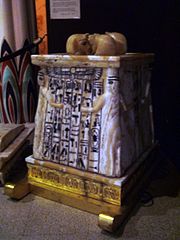
Canopic chest
Encyclopedia
Canopic chests are cases used by Ancient Egyptians to contain the internal organs removed during the process of mummification
. Although the first proven canopic burials date from the 4th Dynasty
reign of Sneferu
, there is evidence to suggest that there were canopic installations at Saqqara
dating from the 2nd Dynasty
.
) of mummies, so they relate to the Egyptian belief that the afterlife is just as important as life on earth. Egyptians believed that everything had to be perfectly preserved to journey into the land after life and as part of the mummification process they removed viscera from the body.

to prepare it for the pigment they then painted it with. All the decoration tells us something about Egyptian religion. The falcon on top represents Sokar, a funerary god and picture on the sides show the chest’s owner worshiping Osiris, god of the afterlife; Ra-Horakhty, a combination of the gods Horus and Ra; four sons of Horus, each of whom guards one of the viscera traditional removed during mummification; the dyed pillar, which represents Osiris, and the tyet
, which represents Isis. The painting is not as perfectly measured and precise as earlier Egyptian art, because Egyptian civilization was decaying when it was made.
Mummy
A mummy is a body, human or animal, whose skin and organs have been preserved by either intentional or incidental exposure to chemicals, extreme coldness , very low humidity, or lack of air when bodies are submerged in bogs, so that the recovered body will not decay further if kept in cool and dry...
. Although the first proven canopic burials date from the 4th Dynasty
Fourth dynasty of Egypt
The fourth dynasty of ancient Egypt is characterized as a "golden age" of the Old Kingdom. Dynasty IV lasted from ca. 2613 to 2494 BC...
reign of Sneferu
Sneferu
Sneferu, also spelled as Snephru, Snefru or Snofru , was the founder of the Fourth dynasty of Egypt. Estimates of his reign vary, with for instance The Oxford History of Ancient Egypt suggesting a reign from around 2613 BC to 2589 BC, a reign of 24 years, while Rolf Krauss suggests a 30-year reign...
, there is evidence to suggest that there were canopic installations at Saqqara
Saqqara
Saqqara is a vast, ancient burial ground in Egypt, serving as the necropolis for the Ancient Egyptian capital, Memphis. Saqqara features numerous pyramids, including the world famous Step pyramid of Djoser, sometimes referred to as the Step Tomb due to its rectangular base, as well as a number of...
dating from the 2nd Dynasty
Second dynasty of Egypt
The second dynasty of ancient Egypt is often combined with Dynasty I under the group title Early Dynastic Period. It dates approximately from 2890 to 2686 BC. The capital at that time was Thinis.-Rulers:...
.
Connections to Ancient Egyptian culture
Canopic chests had an important place in Egyptian culture. Canopic chests contained the internal organs (visceraViscus
In anatomy, a viscus is an internal organ, and viscera is the plural form. The viscera, when removed from a butchered animal, are known collectively as offal...
) of mummies, so they relate to the Egyptian belief that the afterlife is just as important as life on earth. Egyptians believed that everything had to be perfectly preserved to journey into the land after life and as part of the mummification process they removed viscera from the body.

Changes through history
The first canopic chests were simple and wooden, but as time went on they became more elaborate. Then, around the 21st Dynasty (1069-945 BCE) the Egyptians decided to leave the viscera inside mummies. But because they had been using canopic chests for thousands of years they kept putting them in tombs, just without anything in them. Canopic chests fell out of use during the Ptolemaic period.Style and materials
The style and materials were different at different times, though always reflected the Egyptian ideal of perfectly measured and precise beauty.Ptolemaic period
The tall wooden shrine-like chests had bright painting on their sides and a falcon crouching on top. Craftsmen coated the wood with gessoGesso
Gesso is a white paint mixture consisting of a binder mixed with chalk, gypsum, pigment, or any combination of these...
to prepare it for the pigment they then painted it with. All the decoration tells us something about Egyptian religion. The falcon on top represents Sokar, a funerary god and picture on the sides show the chest’s owner worshiping Osiris, god of the afterlife; Ra-Horakhty, a combination of the gods Horus and Ra; four sons of Horus, each of whom guards one of the viscera traditional removed during mummification; the dyed pillar, which represents Osiris, and the tyet
Tyet
The tyet is an ancient Egyptian symbol of the goddess Isis; its exact origin is unknown. In many respects the tyet resembles an ankh, except that its arms curve down...
, which represents Isis. The painting is not as perfectly measured and precise as earlier Egyptian art, because Egyptian civilization was decaying when it was made.

